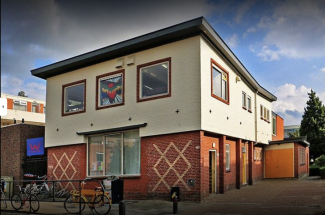
Foundation WEP
WEP is a non-profit organisation that aims to support and assist artists in the development of artistic practice and the production of new work. They promote exchanges between local, national and international artists, cultural institutions and the public. WEP places the artist at the centre of its activities. The public program of multimedia presentations aims to challenge perceptions of what constitutes contemporary art and bring the audience closer to the practice that motivates it.
WEP invites artists to apply for a short-term residency that emphasizes engagement with the unique context of our surroundings. We seek artists who are inspired by the local environment and culture and wish to create work that reflects a deep connection to the setting. Our project space may be used for creating, research, meeting space and exhibitions. In the last weekend of your residence you will organize a public presentation with the artistic outcome of your research during your residency.
In the last weekend of your residence you will organize a public presentation with the artistic outcome of your research during your residency.
Our studiobuilding is located in the former headquarter of the housing association Patrimonium, the building is build in 1953 and kept its typicall 50's vibe. The neighborhood is called 'de Grunobuurt' and its located between the Groningen-Leeuwarden railway line, the Paterswoldseweg, the A7, and the Hoornsediep. Built between 1922-1928, the area is part of the Stadsparkwijk. The name is derived from the housing association for railway personnel 'Gruno,' founded in 1919 and now merged into wbc Nijestee. Gruno is the mythical figure believed to be the founder of Groningen.The housing association managed the majority of the homes in the neighborhood. Most of the houses in the Grunobuurt were designed by the Groningen architectural firm Kazemier & Tonkens. The streets are mostly named after scientists, such as Kamerlingh Onnesstraat, Snelliusstraat, and Stephensonstraat. The latter name (a well-known British locomotive builder) indicates that the northern part of the neighborhood was built for railway workers. Over the past years the neigbourhood changed due to renovation and new appartment buildings.
Groningen is known for its youthful atmosphere, lively cultural scene, and historic charm. The city is home to the University of Groningen, which contributes to a dynamic and international ambiance. The city center features picturesque canals, historic buildings, and cobblestone streets. The Martini Tower, an iconic landmark, dominates the skyline and offers panoramic views of the city. Cycling is a popular mode of transportation, and you'll find that Groningen is very bike-friendly. The city is known for its extensive network of bike paths and bike parks, making it easy to explore the surroundings. The Grote Markt, the central square, is a hub of activity with cafes, restaurants, and shops. You can experience the Dutch café culture here, enjoying a drink or a meal while watching the world go by. Groningen hosts various cultural events, music festivals, and art exhibitions throughout the year. The Groninger Museum is a striking modern building, there are several Art initiatives, an Art Academy and a Conservatory.




